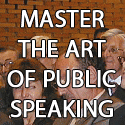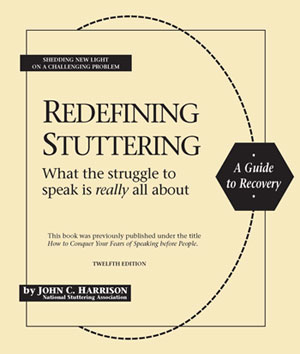Prolonged Speech – In previous posts, I have spoken a lot about the difficulties that people who stutter tend to face, when they are trying to learn and maintain a fluency shaping technique. I have also spoken extensively about the psychological and spiritual sides of approaching the problem. There are a number of mainstream approaches to treating the physical symptoms of stuttering, but one of the most effective approaches that has been developed, is generally known as the Prolonged Speech method. I would like to talk about this approach in the next couple of blog posts.
The Prolonged Speech method also known as Smooth Speech, is the basis of most fluency shaping treatment programs that are taught around the world these days in various forms. The name comes from the fact that in using this method, the person who stutters is initially taught to say words broken down into their syllables, and the utterance of these syllables is “prolonged” to varying degrees for certain reasons that I will talk about below.
 Prolonged Speech is relatively easy to learn, but like most stuttering treatment methods, it can be difficult to transfer into the outside world, unless the individual has a solid grounding in using it in a clinical environment. The practitioner responsible for teaching the method to people who stutter, aims to replace the client’s faltering way of speaking, with a more smooth and controlled way of speaking where the client becomes more aware of all aspects of the speaking process. As such the technique is best and most effectively taught in an intensive course, and the most effective courses have been shown to have a duration of at least 3 weeks. It is a well know understanding in psychology, that it takes 21 days to change a habit, and although stuttering is more than a habit, this understanding is certainly not lost on the effective treatment of stuttering as a behaviour based phenomenon.
Prolonged Speech is relatively easy to learn, but like most stuttering treatment methods, it can be difficult to transfer into the outside world, unless the individual has a solid grounding in using it in a clinical environment. The practitioner responsible for teaching the method to people who stutter, aims to replace the client’s faltering way of speaking, with a more smooth and controlled way of speaking where the client becomes more aware of all aspects of the speaking process. As such the technique is best and most effectively taught in an intensive course, and the most effective courses have been shown to have a duration of at least 3 weeks. It is a well know understanding in psychology, that it takes 21 days to change a habit, and although stuttering is more than a habit, this understanding is certainly not lost on the effective treatment of stuttering as a behaviour based phenomenon.
Approaches to the teaching of the Prolonged Speech method vary from clinic to clinic, but the most effective format is to have a highly trained psychologist or speech pathologist, to work with a group of no more than 6 adults who stutter. The group sits around a table, and while speaking in their new way, are constantly monitored and observed by the clinician to ensure that they are continuously and effectively using the various aspects of Prolonged Speech, in a perfect manner and at the speech rate set for the various speaking sessions. The first week of the intensive is taken up by the process of learning to use Prolonged Speech, and at the same time being highly aware of monitoring the process as speaking is taking place. In the early stage of the first week the client is taught to break words down into syllables and these syllables are uttered with exaggerated prolongations at the beginning. This prolongation rate gradually increases over the week until the client is speaking at what would be an acceptably normal rate or speed. Typically these daily sessions, in the first week, are 10 – 12 hours in length. The second and third weeks of the intensive are used, to have the person who stutters, start to transfer the skills learned in the clinic, into the “outside of clinic” environment. In the second week speech “assignments” are standard assignments set by the clinic, like talking to strangers, using the telephone etc., while in the third week assignments are set by the individuals themselves taking into account where they have had specific difficulties in their daily life. e.g work, home, education environment etc. If the course has been conducted in the correct way by an experienced professional, the result is that all individuals are able to speak fluently in all “outside of clinic” situations at the end of the course, however, unfortunately this is not the result from all clinics purporting to conduct a prolonged speech intensive, but that is a subject to be covered in a subsequent post.
While the immediate post-treatment results from a well run Prolonged Speech intensive are very impressive, like any learned skill, the new method of speaking and associated speech monitoring needs to be constantly used. This can be a very demanding task for most people, when they are faced with pressure in the outside world, to speak faster and more spontaneously, with less focus on all the skills that make up the Prolonged Speech method. For this reason, success in maintaining the level of fluency, achieved during the intensive course, is best facilitated by joining a stuttering support group, where others who are also working on perfecting fluency, gained from the use of Prolonged Speech, are also members.
So what are the “skills” that make up the Prolonged Speech method of controlling stuttering? There are basically 9 parts to this method as follows:
1) The pre-vocalisation out-breath.
2) Gentle onsets.
3) Continuous vocalisation.
4) Control of tongue and lip movements.
5) Prolongation of syllables.
6) Regular controlled pausing.
7) Interesting intonation.
8) Good eye contact.
9) Slow controlled in-breath.
1) The pre-vocalisation out-breath.
In simple terms, stuttering is caused by a locking of the vocal chords or vocal folds situated in the throat. When these folds are closed, air is not able to flow out to create speech. When stuttering occurs, these folds are closed. It is also a common occurrence that these folds are locked closed when speech is about to be initiated. In addition, a problem can occur when one is breathing in instead of out when the individual goes to start to speak. In order to speak, breath needs to be flowing out to first ensure that the vocal folds are open, and then to keep them open and vibrating during speech. The breath needs to continue to flow out while the person is speaking.
2) Gentle onsets.
When the breath is flowing out, the individual must then begin to vocalise sound, but with a gentle onset there is a slow and graduated transition from no sound and no audible speech, to audible speech. If the onset of speech utterance is not slow and gentle, it is possible that the articulators will lock up. It will assist the individual if the onset of all sentence or phrase beginnings is a gentle onset. It is akin to initiating movement of a manual motor vehicle where the clutch needs to be slowly released, for the vehicle to begin moving without a faltering and jerky start.
3) Continuous vocalisation.
When the breath is flowing out, and the vocal folds are vibrating, and speech is being created using the speech articulators (tongue & lips), it is imperative that the underlying vocalisation is continuous. By continuous, I mean that there are no breaks in continuity of sound from when speech commences to when the phrase or utterance finishes. Continuous vocalisation is achieved by the constant out-breath vibrating the vocal folds. You can experience continuous vocalisation by just saying “aaaahhhhhhhhh” for say 5 seconds. It is a continuous sound with no breaks. Continuous vocalisation is important while uttering a phrase or sentence because when sound stops, the vocal folds of a person who stutters are likely to lock closed again, creating a speech block. During the intensive, the clinician ensures that continuous vocalisation is achieved by discouraging the client from using any “uhms”, “ahs” or any other fillers, which are a sign that focus on continuous vocalisation, is not being monitored by the client.
4) Control of tongue and lip movements.
When a person who stutters has a speech block, it is often that the closing and locking of the vocal folds is facilitated by, or given leverage by, pushing the tongue hard against the top of the palette when making the t, d, n and l sounds. Similarly the closing and locking of the vocal folds is facilitated by, or given leverage by, pushing the lips hard together when making b, m and p sounds. As mentioned above, it is imperative that the breath continues to flow out during speech, and this can be facilitated if the person who stutters, is able to control the tongue in such a way that it does not actually touch the top of the mouth during speech, and similarly controlling the movement of the lips, so that they do not actually touch during speech when sounds that would normally require such touching are made.
5) Prolongation of syllables.
As the name implies, the Prolonged Speech technique for controlling stuttering, is given its name because the syllables that make up words, are prolonged when they are uttered. Syllables are prolonged for various reasons. Firstly the syllables are prolonged when this stuttering treatment method is being learned, so that the speech delivery is slowed down so that the various aspects of the method can be learned and mastered. Secondly the process of concentrating on prolonging syllables does certain things in the brain to take awareness while speaking, away from the listener or audience, and onto the processes being used to speak. Finally it has been shown that prolonging of the syllables, when a stuttering moment is encountered, can assist in getting the words out more fluently. As Prolonged Speech is being mastered the prolongation rate is gradually reduced so that speech gets faster, until it reaches the “normal” range of 180 – 200 syllables per minute.
6) Regular controlled pausing.
Breath control is critical for the person who stutters, to be able to control stuttering and produce free flowing stutter-free speech. When a person who stutters begins to utter a phrase or sentence, and what he/she wants to say is coming out fluently, there is a tendency for the person to continue to go on speaking as long as possible, without pausing to take another breath. While a logical reason for this behaviour can be argued, such behaviour can quickly lead to dysfluent speech. The reason for this is that the individual will eventually run out of breath, and the feeling of being out of breath, can trigger stuttering behaviour, like rushed breathing. It is recommended that the person who stutters speaks in shorter, rather than longer, breath lengths and preferably aims to speak in a constant rhythm of breathing, speaking and pausing. This will facilitate the control of the speaking process.
7) Interesting intonation.
When a person who stutters is using continuous vocalisation, combined with prolongation of syllables, there is an initial tendency for the person to develop a somewhat monotone and robotic sort of a sound. This is due to the underlying continuous vocalisation, being made on a limited range of intonation or voice melody. It is imperative that the person learning to master Prolonged Speech, learns to vary the intonation of the vocalisation, in such a way that it takes away any level of monotony in the sound of the speech delivery, and sounds as “normal” as possible.
8 ) Good eye contact.
Good eye contact with the person that one is speaking to, is a good trait for anyone to have, and no more so than for a person who stutters. People who stutter generally tend to look away from the listener, when they are in a stuttering situation. This makes it difficult for both the listener and the person who stutters. When the person who stutters looks away, the listener has a tendency to become embarrassed, and also wants to look away, while the person who stutters tends to lose his power and confidence in the speaking situation.
9) Slow controlled in-breath.
When a phrase or sentence has been uttered, and the vocalisation comes to a temporary halt, it will help to release all residual air in the lungs. At that point it is time to breathe air into the lungs, in order to prepare to start of new “cycle” of speech, for the next phrase or sentence to be uttered. While some stuttering control techniques teach that a fast and full breath should be taken, in this method the in-breath is slow and controlled, and should ideally take 1 – 2 seconds which facilitates the pause, and also formulation of the next phrase or sentence. We do not rush the breath in. At the top of the breath we do not begin to speak, as mentioned in point one above. We must start the whole cycle again, which is to begin by breathing a small amount of air out to open the vocal folds before the vocalisation commences again.
When a proficient exponent of the Prolonged Speech method is speaking, using this stuttering control method, he would be speaking more fluently than most “normal” speakers would be speaking, and the average listener would not be able to detect that he is speaking in any way other than a perfectly fluent normal speaker.
For Prolonged Speech to be effective in all situations, it needs to be used constantly, as it is more a technique to use to stop getting into stuttering behaviour rather than to get out of it. It is not for everyone, and most people other than severe and chronic stutterers, who are highly motivated to achieve total fluency, are unlikely in the long run to give up spontaneous speech, and to put the constant effort and awareness in that is required for this method to control stuttering in all situations. Having said that, it is still the best method available to treat the chronic stutterer and the highly motivated for whom the quest for fluent speech is not negotiable.
This describes the basics of Prolonged Speech. In the next post I will talk further about the more advanced aspects of ensuring that Prolonged Speech really gives the results that every person who stutters is seeking. In the meantime, I again urge you to subscribe to my RSS feed or email notification, so that you do not miss posts about subjects and content that you will not read anywhere else. If you found this post useful or thought-provoking in any way, please make a comment.
Comments:








{ 17 comments… read them below or add one }
Hi Jack-
Tks for sharing this. Would you mind if I reference it on my blog. It is excellent. Lori
Thanks. It was informative. Thanks again:-)
great post. do u know of any clinics in egypt that teach this method?
Hi Jack,
My name is Harish Kaushik from India.Your information are very good and effective. But I want add yoga also.
Hi jack, this is great post,
I am packiaraj from India, I have this problem, I need some audio with technique of prolong . Can You offer?
Dear S. packiaraj,
My stammering cure centre at Mumbai. Mob 9869193109. My training base on yoga. I give personal training.
sir, hi am siva from pondicherry, i have this problem from my childhood but now this s a big issue for me, bcs now am working in gud firm.. so kindly give ur advice and i need to cure by step by step…..
oh my god!….its really working.thanks a lot.
I am from the Philippines. I was treated in Bogue Institute in Indianapolis, Indiana in 1965; in Ithaca Speech Clinic in Binghamton, New York in 1980; in Hollins Institute in Roanoke, Virginia in 1983; and in Eastern Washington University in Cheney, Washington in 1986. I am still interested in your therapy. Geminiano E. Yabut, Jr. gemyabutjr@gmail.com ( 8 David St., Corinthian Gardens, EDSA, Quezon City, Metro Manila, Philippines). Thank you.
If there are inquiries in the Philippines, please inform me. Thank you. Atty. Geminiano E. Yabut, Jr., Ph.D.
Thany you very much for your instructions. They are very helpful. A Merry Christmas and a Prosperous New Year to you. Regards, Atty. Geminiano E. Yabut, Jr., Ph.D.
Great!
I am from Philippines, did you know where in the Philippines I can consult my problem?
yes it is a very big problem for those who are suffering including me.your post is very good and it has generated a hope for me.thanks a lot
Hi,
Great Article, I did prolonged speech with Professor Robert Ingham in the 80s in Australia. I was the youngest to go through the live in course at the time (11 years old) . With follow up for about a year after I haven’t stuttered since.
I can’t thank the people involved enough, really changed my life.
I still get upset when i think about stuttering and all the teasing and bullying as a child.
The residential course enabled the parcipitants to slow down their wpm and slowly bring the speed up over time. It did not work for everyone , but i think persistence is the key factor.
I Believe prf. ingham is now based at University of California.
Good luck to all of you, I hope you find the results you need.
thank you jack. you are bringing lot of hope to my life????
Just started this PS in Singapore SGH, 2 weeks in. For me fluency is non-negotiable, let’s hope I have the motivation to keep it up. It is a different style to my normal speech but I like the feeling if control.